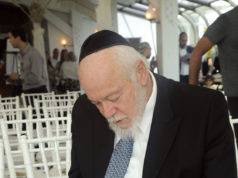
It is generally believed that the Jewish community in Italy began in 161 BCE, when Judah the Maccabee sent a delegation to the Roman Emperor. Four families of Jewish nobility settled in southern Italy and were dependent on Israel for law and prayer. After the destruction of the Second Temple, when Babylonia arose as the new Jewish center, Italian Jews remained loyal to the Jerusalem Talmud.
This is significant because it shows why the earliest Italian Jews placed heavy emphasis in the study of Tannach, had different Hebrew grammar, learned Kabala (Jewish mysticism), midrash (Biblical stories), and wrote piyutim (prayer songs) when those who followed the Babylonian Talmud did not write piyutim or learn midrash. In addition, Italian Jews gave extra significance to custom, to the extent that at times it could override halacha, something that would never happen in Bablylonia. Few people understand that the roots of minhag in Ashkenazic Jewry originate from the first Jews to arrive in Italy.

In 632 BCE, Islam began to spread and 90% of the world’s Jews came under Islamic rule by the end of the 7th Century. Eliezer ben Yehudah of Worms, a descendent from the four original families to come to Italy, wrote that there was major migration from 914 to 957 of Italian Jews moving north who found communities along the way.
Jews who moved north from southern Italy went to Germany and France, bringing with them the Jerusalem Talmud. In 1276 CE, Spain took control of Sicily and in the 1280s, the French invaded southern Italy, bringing with them anti-Jewish legislation. Jews moved to north central Italy, settling in small groups. In 1306, the Jews were expelled from France and moved into the Piedmont area of western Italy. In 1348, the Black Plague came to Germany, killing more than 60% of the population, and Jews were blamed. Life became intolerable in Germany and resulted in a population shift into eastern Italy. And in 1492, when Spain expelled its Jews, Sephardic Jews began to settle in Italy as well. So by the end of the 14th Century, Italy had become a mix of French, German, and Spanish Jews competing against the original Jewish settlers, each with their own customs and languages.
However, life in Italy during the Middle Ages was extremely unstable for Jews, who negotiated their stay in each city under a contract called a condutta, which allowed a certain group to stay for a limited amount of time. The condutta could be annulled at any time. As a result Jewish life was unstable. No synagogues or mikvehs were built. As a result of the condutta, Jews lived in small numbers, usually not enough for a minyan, in hundreds of localities and in isolation from organized Jewry.
Italian Jewry produced a few prominent rabbis of note. Rabbi Joseph Cologne also known as the Maharik (1420-1480), wrote rabbinical response clearly showing the conflict between German and French influences on Italian Jewry. Rabbi Judah Messer Leon was Italian, with a profound secular education. He was an accomplished physician and philosopher, who received the title Messer (sir) and Leon (Lion- Lion of Judah). He was anointed a knight and was given the rights to give doctorate degrees. Rabbi Messer Leon established a yeshivah in Ancona, had many disciples, and in 1473 was the first Jew to see his own book published while he was still alive (Mantua). Nofet Tsofim (which was translated into English as The Book of the Honeycombs Flow, trans. by A. Lesley), is an analysis of language and how rhetoric can be used for convincing others based on ancient rhetoric models of Cissero and Quintilian. Leon measured the Torah against their models to show how the Torah is perfect and embodies every kind of ideal rhetoric. Messer Leon also showed that one can have a lot of culture as well as being strict on religious matters.
In the second half of the 15th Century, Rabbi Elijah Capsali (1490-1560) was born to a German Jewish family that migrated to Crete (ruled by Venice). He was a Rav and a historian who wrote Seder Elijah Suda (The Lesser Order of Elijah), a book of Venician chronicles that provided the history of Torah Study in Venice. Other rabbis of note include Rabbi Yehuda Minz and Rabbi David Provencal.
It was not until 1590 that the Jews of Italy began to live in walled communities and ghettos, which created larger Jewish communities where Judaism could thrive with schools, minyanim, and a place where the population could regenerate itself. Italian Jews were always citizens with equal rights until the last part of the 16th Century when Venice created the first ghetto. Citizenship was not granted to the Jews in France and Germany until the Emancipation of the 18th and 19th Centuries. In addition, condutta were no longer needed and ghettoes allowed the Jews to live autonomously, ruling themselves. As a result, the first Italian synagogues were built after 1590.
The Italian Jewish community as we know it today has a different and varying history, one which is heavily influenced by population shifts from France, Germany, and Spain, as well as their languages and customs.



